Abstract
Religious pluralism is an important and contested topic within the literature on religion. This article explores the spatiality of religious diversity in the United States. It opens with a summary of major conceptual perspectives on the causes and consequences of religious diversity. Second, to unpack the geography of U.S. religious diversity, the article uses Glenmary and Polis data for 2000 to construct four indexes of diversity and presents these results with both choropleth maps and Dorling cartograms. It explores the relation between the distribution of denominations and county population size. The analysis reveals that the most diverse regions include the Pacific Northwest, a broad belt stretching from Denver to Pittsburgh, and central Florida, and the least diverse parts are dominated by Mormons, Baptists, and Catholics. Indexes more sophisticated than the simple number of denominations per county are sensitive to the internal configuration of adherents and reflect a more complex relationship in which population size is not assured of generating greater degrees of religious diversity.

El pluralismo religioso es un tema importante y controversial en la literatura sobre religión. En este artículo se explora la distribución espacial de la diversidad religiosa en Estados Unidos. Se inicia con un resumen de perspectivas conceptuales importantes sobre las causas y consecuencias de la diversidad religiosa. Segundo, para analizar la geografía de la diversidad religiosa de Estados Unidos, el artículo usa los datos de Glenmary y de Polis de 2000 para construir cuatro índices de diversidad, y presenta estos resultados con mapas coropletos y cartogramas de Dorling. Explora la relación entre la distribución de religiones y el tamaño de la población del condado. El análisis revela que las regiones más diversas incluyen el Noroeste Pacífico, una amplia franja que se extiende desde Denver hasta Pittsburg, y la región central de Florida; las áreas menos diversas son dominadas por mormones, bautistas y católicos. Los índices más sofisticados que el simple número de religiones por condado son más sensibles a la configuración interna de seguidores y refleja una relación más compleja en la que el tamaño de la población no significa la generación de mayores grados de diversidad religiosa.
Palabras claves:
The geography of religion has recently received renewed and growing interest. Whereas older work on this topic confined itself primarily to the level of the empirical (CitationZelinsky 1961; CitationSopher 1981; CitationLevine 1986; CitationWilson 1993), more recent research has aspired to more sophisticated conceptual heights, stressing the social and political roles and contexts that religion occupies (CitationKong 1990, Citation2001; CitationTong and Kong 2000; CitationValins 2000; CitationZelinsky 2001; CitationVincent and Warf 2002; CitationHervieu-Léger 2002). In addressing the spatiality of religion, geographers have unearthed the manner in which religious beliefs mold everyday life, uniting individuals within broader communities of faith (CitationProctor 2006a). Globally, the rise in religious fundamentalism since the end of the cold war has also gained attention (CitationStump 2000).
In the United States, religion has long been a potent social force. From the nation's founding, religion played an important role in American politics (CitationPhillips 2006), as exemplified historically by the antislavery movement, agrarian socialism, Prohibition, and the civil rights struggle. De Tocqueville observed more than 150 years ago that the United States had a religious pluralism and vitality not found in Europe; indeed, the U.S. political mythology of the “New Zion” or “city on the hill” contrasted with the legacy of feudalism in Europe (CitationHertzke 1988). In contrast to most industrialized countries, the United States exhibits significantly higher levels of religiosity (CitationHackett 2003). Religion has recently surfaced as a potent political issue, particularly given the influential role of conservative Christian activists within the Republican Party (CitationWilcox 1991; CitationHeineman 1998). Religious belief is central to the “culture wars” and debates regarding issues such as prayer in the schools, reproductive rights and contraception, sex education, tolerance of homosexuality, the teaching of evolution, stem cell research, and a variety of other important topics that are often loosely lumped under the phrase “moral values.” Indeed, many Republican Party state political platforms assert unabashedly that the United States is a Christian nation, and label the separation of church and state a myth (CitationPhillips 2006).
The United States is arguably the single most religiously diverse society in the world (CitationEck 2001). The numerous forces fomenting religious diversity in the United States have deep historical roots. As a magnet for immigrants from around the world, the country attracted members of a broad array of faiths from Europe, including its early Anglican, Methodist, and Presbyterian founders and waves of Catholic immigrants. Religious affiliation simultaneously enabled the integration and social mobility of immigrants and often ostracized them by hegemonic elites. Other variants of Christianity that were relatively minuscule in Europe, such as Baptists, flourished to become the nation's largest single denomination and arguably its most politically influential (CitationPhillips 2006). Besides religions that began elsewhere and were imported by immigrants, the United States generated new faiths such as the Seventh Day Adventists, Church of Christ, and the Mormons (Church of Jesus Christ of Latter-day Saints). The constitutionally enshrined separation of church and state in the United States (in contrast, say, to Canada or the United Kingdom, which long had “established” state-legitimized denominations) also generated a relatively free arena in which different faiths competed and flourished (and may have enhanced religiosity; that is discussed in more detail later). Finally, the adherents of denominations exhibit differential fertility rates, which also contribute to their uneven distribution over time; typically, highly devout and evangelical denominations have the highest birth rates (M. Hout, Greeley, and Wilde 2001). Given the high degree of spatial mobility that has historically characterized American society, local places often witnessed considerable mixing of different faiths, producing complex local and national geographies of diversity (CitationZelinsky 2001).
This article starts by briefly summarizing contending conceptual explanations of the causes of American religious diversity and its relation to religiosity; it does not attempt the indomitable task of summarizing this extensive literature in depth, as its focus is primarily empirical and methodological. Second, it empirically analyzes how religious diversity varies across the nation's variegated landscape, explaining the source of data utilized and four measures of religious diversity drawn from different disciplines. Diversity, it is argued, is a robust and meaningful concept, not simply a statistical artifact, to the extent that it is measurable by different means. Third, the article focuses on how religious diversity is related to county population size in two ways, first by offering a statistical model and second by utilizing Dorling cartograms that complement conventional choropleths. The conclusion summarizes the major findings.
Competing Perspectives on Religious Competition
The role and impacts of religion must be situated within the long history and complex geographies of different faiths in the country, which exhibit enormous and growing diversity. The geography of religion in the United States consists of a vast panoply of denominations scattered unevenly across the national landscape. Christians of different denominations still make up the majority of the total population, but that proportion has gradually declined in the face of growing populations of nonreligious people and non-Christian faiths, particularly in larger cities. As indicates, Catholics comprise the largest single faith, with 22 percent of the population, followed by Protestants of various denominations (who collectively comprise almost one-third of the country), Jews (2.2 percent), various “Eastern religions,” and Muslims. Thus, the Christian majority has been slowly complemented by growing numbers of Jews, Muslims, Hindus, and others (CitationSmith 2002). Notably, 40 percent of the public has no formal religious affiliation, a diverse group that includes atheists and agnostics as well, in some contexts, members of small, independent churches who do not identify with any larger, formal denomination.
Table 1 Distribution of major religions in the United States, 2000
Theorizations about the causes of religious diversity include the predominant view, articulated most explicitly by CitationFinke and Stark (1988), which likens the competition among faiths for adherents to that of firms seeking to maximize market share; adherents are likewise comparable to consumers choosing among different brands of products (see CitationBruce 2002; CitationStark and Finke 2000). From this perspective, religious choice is predicated on a rational, utilitarian cost–benefit calculus that portrays individuals as sentient and active in the choice of their faith. This view is particularly pertinent to the unique political context of the United States, where the legal separation of church and state, as enshrined in the First Amendment, obliges different religions to compete with one another for followers (CitationRoof 1999). The exceptionally high degree of individualism that has long characterized American culture is also conducive to a view in which markets and religion are seen to resemble one another in organization and practice. Thus, Stark and Finke (2000, 277) conclude that “The American religious economy surpasses Adam Smith's wildest dreams about the creative forces of a free market.” The extreme of this line of thought is rational-choice and game-theoretic approaches (CitationDurkin and Greeley 1991; CitationMontgomery 1996, Citation2003; CitationYoung 1997), which reduce the question of choice among denominations to a neoclassical, individualistic, utility-maximizing approach utterly devoid of emotional or ideological content or social context.
Conceptual objections to the dominant economic model of religious choice question whether different denominations may be treated realistically as profit-maximizing institutions. Modeling religious choice on shopping offers a simplistic, undersocialized view that dismisses the deeply social and psychological dimensions of religious faith and participation. Most people, for example, do not explicitly compare religious alternatives before choosing, but adopt the faith into which they were born and socialized. Shifting one's allegiance from one denomination to another is a difficult, often stressful process fraught with uncertainty, and understandably rare, a process radically different from choices made by consumers selecting among different products.
An alternative, social ecological approach emphasizes the sociopsychological dimensions of religious adherence; that is, the cognitive and behavioral aspects of people's religious identities and choices regarding participation in religious activities (CitationMcPherson 1983; CitationReynolds and Tanner 1995). Unlike isolated actors with perfect information maximizing a single, given objective, this perspective focuses on the social and spatial context of faiths; the durability of religious identity, which, like ethnicity, changes very slowly; and the manner in which denominations mobilize resources. The popularity of particular faiths will reflect, inter alia, their relative ability to appeal to particular audiences; that is, the compatibility between denominational doctrine and popular preferences on a variety of social issues (e.g., gender roles, the infallibility of the Bible, or various topics that surface periodically in the culture wars). In this view, factors such as changing demographic and ethnic composition, fluctuating generationally specific beliefs, effective leadership or lack thereof, and the differential ability of denominations to utilize the media (e.g., televangelism) are central to the competitive ability of faiths to attract followers. Religious choice in this perspective is an irreducibly social rather than individual phenomenon.
Debates about religious diversity among sociologists focused on its relation to religiosity and participation in religious activities. Traditionally, secularization theory asserted that pluralism decreased religious participation, a claim grounded in the assumption that the presence of multiple religions undermined the appeal of any particular faith (CitationBerger 1967). For example, Olson and Hadaway (1999, 491) maintain that “religious pluralism lowers religious involvement by reducing the number of close social ties—especially personal family and friendship connections—that people maintain with others who share a common religious identity.” However, Finke and Stark (1988, 1998) offered a powerful counterargument, holding that because religious pluralism stimulates competition among denominations by offering individuals more choices, it encourages religious participation (in contrast, say, to the United Kingdom and the Established Church of England). In this view, religious diversity and interfaith competition lead to more aggressive proselytization and recruitment strategies and, as a result, higher levels of religiosity as well. This line of thought was aptly summarized by Kohut and Stokes (2006, 103):
By almost every measure, the United States is the most religious rich nation in the world. Indeed, it is the only religious rich nation in the world…. Americans are more religious than other wealthy, educated peoples because they live in a more open religious market, with more churches and greater variety of religious perspective competing for their devotion. With more options, Americans have blossomed into great consumers of religion. Secular Europeans, in contrast, live in an uncompetitive market.
Indeed, it is likely no coincidence that in countries in which one faith enjoys the backing of the government, levels of religiosity and church attendance are relatively low (G. Hout and Fischer 2002).
It is not the intention of this article to enter this debate, particularly as it makes no attempt to assess religiosity. Engaging in extended analysis of the causes and consequences of religious diversity is thus beyond its scope. Rather, the purpose here is primarily to shed light on how religious diversity varies empirically across the national landscape of the United States.
Data and Methodology
The source of data used in this analysis was the census published by the Glenmary Research Center (2002) on the nation's religious denominations in 2000, which lists numbers of adherents by denomination for each county. Data were obtained by requests sent to 285 religious bodies, of which 149 responded; within these, only 68 reported their number of adherents. Although the Glenmary data are generally recognized as being the best available, they are not without flaws. Notably, some large denominations such as the Jehovah's Witnesses refused to participate, and Glenmary omitted African Americans, a failure addressed later. In some cases, Glenmary's approach led to counties having more adherents than their population, a discrepancy the center ascribes to either a census undercount, overestimations of church membership, or adherents living in one county and attending church in another.
This article uses the reconfigured Glenmary database produced by the Polis Center at Indiana University (www.polis.iupui.edu). Polis Center researchers added information to the Glenmary database, including the number of nonadherents by county as well as an estimate of the number of African American adherents. The Polis Center's estimates of African American religious adherents are an enormous bonus, as the Glenmary Research Center was unable to obtain their participation in its census and did not make estimates. Because they make up 12 percent of the country's population and are heavily represented in specific regions (e.g., the South) and in specific denominations (e.g., Baptists), the rectification of this omission was a helpful addition.
The geographically uneven significance of religion in American society is revealed in , which shows the proportion of the population in each of the country's 3,142 counties who were religious adherents of any sort in 2000. The average proportion was 61 percent, and ranged from zero (Loving, Texas, with sixty-five residents and no church) to 174 percent (Falls Church, Virginia, which attracts large numbers of adherents who live in neighboring counties). Counties with the highest proportions were concentrated in the sparsely populated Upper and Lower Great Plains and Utah and southern Idaho, where the Latter-day Saints (Mormons) are predominant. Counties where the proportion of population who were adherents was relatively low were located primarily in the relatively secular Pacific Northwest and northern California, Nevada and Arizona, southwestern Ohio and West Virginia, Maine, and the western Florida peninsula.
Figure 1 Religious adherents as percentage of total county population, 2000. Intervals contain equal numbers of counties. (Source: Glenmary and Polis data.)
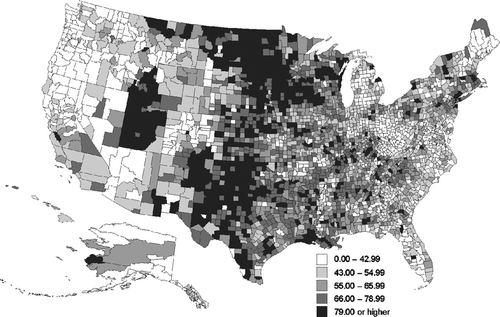
There is no single explanation for this pattern. To some extent, the geography of religiosity (as measured by the proportion of residents who are adherents) reflects population density: Often counties with the highest proportions of adherents are relatively small in population size and have relatively few denominations, which lends support to the thesis advanced by Breault (Citation1989a, Citation1989b), Olson (Citation1998, Citation1999), CitationChaves and Gorski (2001), and Voas, Olson, and Crockett (2002), who argue that religious diversity tends to minimize religiosity. For some counties, particularly in Florida and Nevada, low relative levels of religiosity may reflect high levels of in-migration during the past several decades: New in-migrants, particularly the young, may not so readily identify with a particular denomination.
Measuring diversity is no easy task. Biologists, for example, have developed many measures of species diversity (CitationMagurran 2004). The simplest index is species richness, a simple count of the different types of species not taking into account their relative abundances. However, such an index is inadequate to convey a region's biological diversity if most observations belong to a single species. Thus, more meaningful measures must reflect not only the number of species—or in this case, denominations—but also their relative distributions. Admittedly, comparing denominations to species is theoretically suspect; however, without asserting any conceptual congruence between the two phenomena, it is possible to import indexes used to measure one to study the other.
This article employed four empirical measures of religious diversity drawn from different disciplines:
-
The simple number of denominations present in each county, n. It represents the number of religious choices available to individuals without regard to their size.
-
Total adherents who belong to the county's largest denomination (n max) as a proportion of the total (i.e., n max/N, where N = total number of adherents). This measure assesses the relative dominance of one faith in particular areas.
-
Shannon's index (H), a widely used entropy-maximizing measure that quantifies diversity based on the number of denominations and their proportional areal distribution (CitationMagurran 2004). It is calculated by adding for each denomination the product of the proportion of adherents and its natural logarithm,
in which p is the proportion of a county's adherents found in denomination i. The maximum value is attained when all denominations have the same distribution. -
Simpson's index (D), which assesses the probability that two individuals drawn at random will fall in the same denomination (CitationSimpson 1949). It is defined as
If these indexes reflect fundamentally incomparable forms of religious diversity, one may expect them to differ in their results; conversely, to the extent that religious pluralism is constant despite the empirical measure deployed, they will resemble one another. Consensus among different measures is thus essential to understanding the degree to which religious diversity is ontologically real or simply a methodological by-product.
The cartographic depictions of these indexes are illustrated in two types of maps. The first includes standard choropleth maps based on counties, a perspective that suffers from the common disadvantage of exaggerating the significance of areally large counties as compared with small ones. Thus, high values of the variable being mapped can easily be visually overlooked if contained in a very areally small county. To avoid misrepresenting the population sizes of counties, the choropleths were supplemented by CitationDorling (1995) cartograms, in which circles are deployed proportional to the population of counties, maintaining topological neighbor relationships. The basic Dorling cartogram can then be elaborated by shading the circles according to a second variable. Although sometimes visually challenging, Dorling cartograms nevertheless assist data interpretation and minimize problems engendered by conventional cartographic representations.
Cartographic Representations of U.S. Religious Diversity
The first measure of diversity is simply the number of denominations per county (), which ranged from zero to 102. High numbers of denominations (twenty-six or more) are found in counties located on a broad arc extending across the West Coast, the northeastern manufacturing belt, central Florida, and more generally, in populous metropolitan regions. Conversely, counties with relatively few denominations (nine or fewer) are stretched across the Great Plains and intermontane West, particularly Utah.
Figure 2 Number of denominations per county, 2000. Intervals contain equal number of counties. (Source: Glenmary data.)
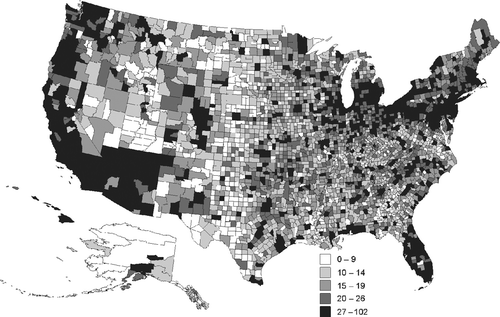
Of interest here is the relationship between number of denominations (D) and population of each county (P), which is analogous to the class species–area curve of island biogeography (CitationMacArthur and Wilson 1967). A scatter plot of these data is shown in , where it can be seen that it is a structural relationship, with Los Angeles and Cook counties standing out as both the most populous and most diverse. This pattern was analyzed using the following regression model (sometimes called Hoerl's function, which is more flexible than a simple logarithmic model):
Figure 3 Scatter diagram of number of denominations with county population, 2000. (Source: Glenmary data.)
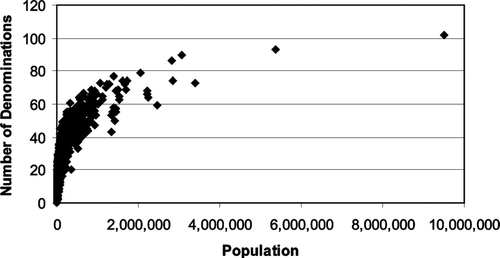
Table 2 Regression estimates
The results are highly significant statistically at the .99 confidence level. The regression residuals from the fitted Hoerl's function are mapped in . Negative residuals (fewer denominations than predicted) tend to be located in a large portion of the Southeast; Utah and parts of Arizona, Nevada, and Southern California; and the northeastern seaboard. Positive residuals (more denominations than predicted) are located on the West Coast; parts of the Great Plains; the industrialized region stretching across the lower Great Lakes; and central Florida.
Figure 4 Residuals from regression of denominations with population, 2000. Intervals contain equal numbers of counties. (Source: Glenmary and Polis data.)
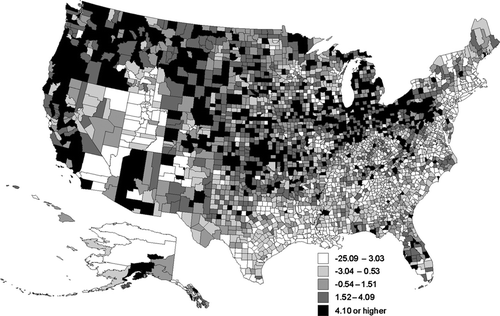
The second measure of diversity, the proportion of each county's adherents who belong to the largest denomination (), offers a relatively simple but convincing image of the geography of diversity. The least diverse counties, in which 63 percent or more of adherents belong to a single denomination, fall into three major clusters, including the heavily Mormon heartland in Utah and southern Idaho, the Baptist “Bible Belt” across much of the South (as well as predominantly Catholic southern Louisiana and south Texas), and largely Catholic counties in the Northeast megalopolis. More diverse counties, in contrast, in which the largest denomination accounts for less than one-third of adherents, are found in the coastal Pacific Northwest and a broad swath stretching across the Corn Belt from Kansas to West Virginia. It may be observed that the Mason–Dixon line demarcating the traditional northern boundary of the South is still reflected in the sharp distinction between counties in Ohio, Indiana, and Illinois on the one hand and Kentucky and Tennessee on the other. This long-standing boundary not only differentiates the relatively homogenous South, dominated by Baptists—the “State Church of the Ex-Confederacy” (CitationPhillips 2006, 248)—from the more diverse northern and midwestern states, but indicates that despite decades of migration, social change, and demographic transformation, the older cultural geography of the United States continues to haunt contemporary patterns.
Figure 5 Share of total adherents in each county's largest denomination, 2000. Intervals contain equal number of counties. (Source: Authors, using Glenmary data.)
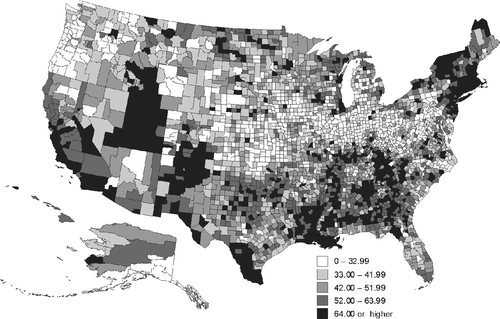
Shannon's Diversity Index, the third measure used here, yielded a similar pattern as depicted in a Dorling cartogram (). In this reading, the greatest religious diversity is found in a broad tier across the northern United States, stretching from the Pacific Northwest across the northern Great Plains and the Corn Belt, as well as the southern part of the northeastern megalopolis. Central Florida also exhibited considerable diversity. In contrast, the index reflects the low diversity in Utah and southern Idaho, northern New Mexico, significant portions of Texas and the South, and parts of New England. By circumventing the problem of large differences in the areal sizes of counties, the Dorling cartogram illustrates both county population magnitude and religious diversity as measured by the Shannon index. This representation emphasizes clearly the relatively low population size of the Upper Midwest and intermontane West, which are also low in their degree of religious diversity. New England, which is relatively populous, exhibits remarkably low diversity given the predominance of Catholicism there. Unlike the simple measure of the number of denominations, by this measure Los Angeles County, although large, does not exhibit the degree of diversity that one might expect given its size and role as one of the country's primary entry points for immigrants, likely due to the large numbers of Hispanic Catholics there. The Simpson index offers a similar reading of the landscape of U.S. religious diversity (), largely because the Simpson and Shannon measures were highly correlated (r = 0.94).
Figure 6 Shannon index of religious diversity in 2000, Dorling cartogram. Intervals contain equal numbers of counties. (Source: Glenmary and Polis data.)
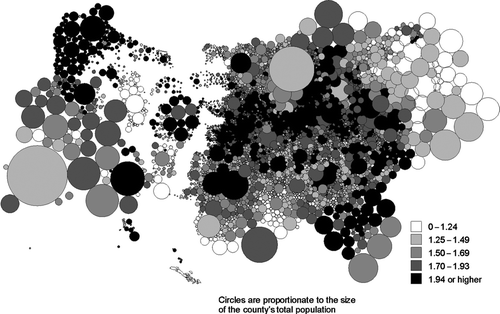
Figure 7 Simpson index of religious diversity in 2000, Dorling cartogram. Intervals contain equal number of counties. (Source: Glenmary and Polis data.)

In both the maps of the Shannon and Simpson indexes, it is apparent that there is little relationship between the size of a county's population and the degree of diversity of religious adherents within it. Two of the best examples to illustrate this notion are the heavily populated counties of Salt Lake in Utah (population 893,387), dominated by Salt Lake City, and Richmond County (Staten Island), New York (population 443,738). There were forty denominations represented in Salt Lake City in 2000, but Mormons comprised 82 percent of its adherent population. In Staten Island, there were thirty-six denominations identified, but Catholics constituted 76 percent of the adherent population. This conclusion may seem to stand at odds with the argument advanced previously concerning the number of denominations per county and its relation to population size. The reasons for this discrepancy lie in the different ways in which diversity is captured by the measures employed here. Thus, the number of denominations per county depicted in and , which do not include information about adherents, is closely related to population size, whereas the Shannon and Simpson indexes include the weighted distribution of adherents in each county, and thus offer a different and more nuanced measure of religious diversity. The utilization of these indexes indicates that large cities are not always significantly higher in their degree of religious diversity, and that because diversity is a complex and multifaceted phenomenon, several measures are necessary to encompass its various dimensions.
Conclusions
Given the growing significance of religion to American public life, geography's silence on this topic is deafening. The literature on the geography of religion is relatively sparse, although it has recently undergone reinvigoration (CitationProctor 2006a, Citation2006b). The very size, lengthy immigration history, and political culture of religion in the United States—which, like many other aspects of the society, has been shaped largely by comparatively low degrees of state intervention—have combined to generate a geography of diverse faiths that is complicated and often convoluted. This complexity renders any cartographic interpretation of religious diversity challenging.
This article has assessed the spatial distribution of religious diversity in the United States using four different quantitative indexes. All four measures point to three regions of relatively high diversity: the Pacific Northwest, a broad belt stretching from Denver to Pittsburgh, and central Florida. Conversely, regions with the least diversity are to be found in counties where Mormons predominate (Utah, southern Idaho) as well as those dominated by Baptists (much of the South) and, to a lesser extent, Catholics (the Northeast and Southwest). Thus, the map of religious diversity is robust with respect to methodology: However it is measured, its spatiality remains similar on a broad scale. The Dorling cartograms reveal the critical role played by population size, for typically counties with large numbers of adherents are the most diverse. However, measures such as the number of denominations per county, which are indifferent to the relative sizes of each faith, tend to exaggerate the importance of population size, whereas more sophisticated approaches such as the Simpson and Shannon indexes, which do include the distribution of adherents across denominations within each county, provide an alternative reading in which population size does not monotonically generate diversity. Thus, using multiple indexes and two cartographic approaches, this article attempts to convey both the complexity of American religious diversity and its multidimensional spatiality.
Acknowledgments
BARNEY WARF is Professor of Geography at Florida State University, Tallahassee, FL 32306. E-mail: [email protected]. He has a broad array of research interests in human geography, including services and telecommunications, political geography, globalization, and political economy.
MORT WINSBERG is Professor Emeritus of Geography at Florida State University, Tallahassee, FL 32306. E-mail: [email protected]. His research interests include the geography of Florida, crime, weather, and cultural landscapes.
Notes
aIncludes Buddhism, Hinduism, Sikhism, Confucianism, and Taoism.
*The authors thank several reviewers for their helpful and constructive criticisms.
Literature Cited
- Berger , P. 1967 . The sacred canopy: Elements of a sociological theory of religion , New York : Doubleday .
- Breault , K. 1989a . New evidence on religious pluralism, urbanism and religious participation . American Sociological Review , 54 : 1048 – 53 .
- Breault , K. 1989b . A re-examination of the relationship between religious diversity and religious adherents: Reply to Finke and Stark . American Sociological Review , 54 : 1056 – 59 .
- Bruce , S. 2002 . God is dead: Secularization in the West , Oxford, , U. K. : Blackwell .
- Chaves , M. and Gorski , P. 2001 . Religious pluralism and religious participation . Annual Review of Sociology , 27 : 261 – 81 .
- Dorling , D. 1995 . A new social atlas of Britain , Chichester, , U. K. : Wiley .
- Durkin , J. and Greeley , A. 1991 . A model of religious choice under uncertainty . Rationality and Society , 3 : 178 – 96 .
- Eck , D. 2001 . A new religious America: The world's most religiously diverse nation , San Francisco : HarperCollins .
- Finke , R. and Stark , R. 1988 . Religious economies and sacred canopies: Religious mobilization in American cities . American Sociological Review , 53 : 41 – 49 .
- Finke , R. and Stark , R. 1998 . Religious choice and competition . American Sociological Review , 63 : 761 – 66 .
- Glenmary Research Center . 2002 . Religious congregations & membership in the United States , Atlanta, GA : Glenmary Research Center .
- Hackett , D. 2003 . Religion and American culture , London : Routledge .
- Heineman , K. 1998 . God is a conservative: Religion, politics, and morality in contemporary America , New York : New York University Press .
- Hertzke , A. 1988 . American religion and politics: A review essay . The Western Political Quarterly , 41 : 825 – 38 .
- Hervieu-Léger , D. 2002 . Space and religion: New approaches to religious spatiality in modernity . International Journal of Urban and Regional Research , 26 : 99 – 105 .
- Hout , G. and Fischer , C. 2002 . Why more Americans have no religious preferences: Politics and generations . American Sociological Review , 67 : 165 – 190 .
- Hout , M. , Greeley , A. and Wilde , M. 2000 . The demographic imperative in religious change in the United States . American Journal of Sociology , 107 : 2 – 21 .
- Kohut , A. and Stokes , B. 2006 . America against the world , New York : Holt .
- Kong , L. 1990 . Geography and religion: Trends and prospects . Progress in Human Geography , 14 : 355 – 71 .
- Kong , L. 2001 . Mapping “new geographies” of religion: Politics and poetics in modernity . Progress in Human Geography , 25 : 211 – 33 .
- Levine , G. 1986 . On the geography of religion . Transactions of the Institute of British Geographers , 11 : 428 – 40 .
- MacArthur , R. and Wilson , E. 1967 . The theory of island biogeography , Princeton, NJ : Princeton University Press .
- Magurran , A. 2004 . Measuring biological diversity , Oxford, , U. K. : Blackwell .
- McPherson , M. 1983 . An ecology of affiliation . American Sociological Review , 48 : 519 – 32 .
- Montgomery , J. 1996 . Dynamics of the religious economy: Exit, voice, and denominational secularization . Rationality and Society , 8 : 81 – 110 .
- Montgomery , J. 2003 . A formalization and test of the religious economies mode . American Sociological Review , 58 : 782 – 809 .
- Olson , D. 1998 . Religious pluralism in contemporary U. S. counties . American Sociological Review , 63 : 759 – 61 .
- Olson , D. 1999 . Religious pluralism and US church membership: A reassessment . Sociology of Religion , 60 : 149 – 74 .
- Olson , D. and Hadaway , C. 1999 . Religious pluralism and affiliation among Canadian counties and cities . Journal for the Scientific Study of Religion , 38 : 490 – 508 .
- Phillips , K. 2006 . American theocracy , New York : Viking .
- Proctor , J. 2006a . Introduction: Theorizing and studying religion . Annals of the Association of American Geographers , 96 : 165 – 68 .
- Proctor , J. 2006b . Religion as trust in authority: Theocracy and ecology in the United States . Annals of the Association of American Geographers , 96 : 188 – 96 .
- Reynolds , V. and Tanner , R. 1995 . The social ecology of religion , Oxford, , U. K. : Oxford University Press .
- Roof , W. 1999 . Spiritual marketplace , Princeton, NJ : Princeton University Press .
- Simpson , E. 1949 . Measurement of diversity . Nature , 163 : 688
- Smith , T. 2002 . Religious diversity in America: The emergence of Muslims, Buddhists, Hindus and others . Journal for the Scientific Study of Religion , 41 : 577 – 85 .
- Sopher , D. 1981 . Geography and religion . Progress in Human Geography , 5 : 510 – 24 .
- Stark , R. and Finke , R. 2000 . Acts of faith: Explaining the human side of religion , Berkeley : University of California Press .
- Stump , R. 2000 . Boundaries of faith: Geographical perspectives on religious fundamentalism , Boulder, CO : Rowman & Littlefield .
- Tong , C. and Kong , L. 2000 . Religion and modernity: Ritual transformations and the reconstruction of space and time . Social and Cultural Geography , 1 : 29 – 84 .
- Valins , O. 2000 . Institutionalised religion: Sacred texts and Jewish spatial practice . Geoforum , 31 : 575 – 86 .
- Vincent , P. and Warf , B. 2002 . Eruvim: Talmudic places in a postmodern world . Transactions of the Institute of British Geographers , 27 : 30 – 51 .
- Voas , D. , Olson , D. and Crockett , A. 2002 . Religious pluralism and participation: Why previous research is wrong . American Sociological Review , 67 : 212 – 30 .
- Wilcox , C. 1991 . God's warriors: The Christian right in twentieth century America , Baltimore : Johns Hopkins University Press .
- Wilson , D. 1993 . Connecting social process and space in the geography of religion . Area , 25 : 75 – 76 .
- Young , L. 1997 . Rational choice theory and religion: Summary and assessment , New York : Routledge .
- Zelinsky , W. 1961 . An approach to the religious geography of the United States: Patterns of church membership in 1952 . Annals of the Association of American Geographers , 51 : 139 – 93 .
- Zelinsky , W. 2001 . The uniqueness of the American religious landscape . Geographical Review , 91 : 565 – 85 .